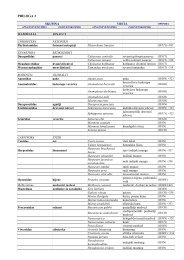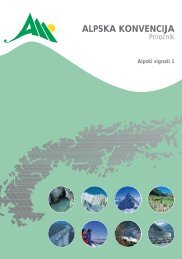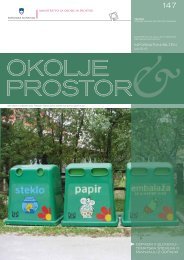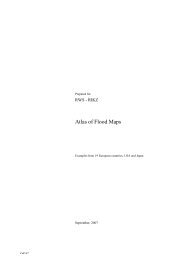The restoration of tributaries of Cerknica Lake and Škocjan Caves ...
The restoration of tributaries of Cerknica Lake and Škocjan Caves ...
The restoration of tributaries of Cerknica Lake and Škocjan Caves ...
You also want an ePaper? Increase the reach of your titles
YUMPU automatically turns print PDFs into web optimized ePapers that Google loves.
another entrance to the underground, a ninety-metre-deep abyss called Okroglica, which ends<br />
just above the underground Reka River.<br />
At the bottom <strong>of</strong> Velika dolina, the Reka River finally disappears underground <strong>and</strong> resurfaces<br />
again thirty-four kilometres away at the springs <strong>of</strong> the Timava River, not far from the Adriatic<br />
coast. Part <strong>of</strong> the <strong>Škocjan</strong> <strong>Caves</strong> in which the Reka River flows, namely the Šumeča jama (the<br />
Murmuring Cave), is 3.5 kilometres long, between 10 <strong>and</strong> 60 metres wide <strong>and</strong> over 100<br />
metres high underground canyon. <strong>The</strong> length <strong>of</strong> all cave passages totals approximately 6<br />
kilometres, while the vertical difference between the highest entrance (Okroglica abyss) <strong>and</strong><br />
the lowest point in the caves reached by man, that is the siphon, is 205 metres. At some<br />
places, the canyon extends into underground chambers. <strong>The</strong> largest <strong>of</strong> them, Martel's<br />
Chamber, is 308 metres long, 89 metres wide on average (reaching a maximum <strong>of</strong> 123<br />
metres) <strong>and</strong> 106 metres high, with the highest point <strong>of</strong> the ceiling at 146 metres above the<br />
Reka River bed. <strong>The</strong> largest cross-section measures 12,000 square metres, thus giving this<br />
chamber a volume <strong>of</strong> 2.2 million cubic metres.<br />
2.3. Projects <strong>and</strong> research activities<br />
One <strong>of</strong> the most important activities <strong>of</strong> the park is the encouragement <strong>and</strong> organization <strong>of</strong><br />
research work <strong>and</strong> participation in it. Following various inventories prepared at the time <strong>of</strong><br />
park’s establishment, the majority <strong>of</strong> activity is oriented towards the renovation <strong>of</strong> cave<br />
infrastructure <strong>and</strong> establishment <strong>of</strong> continuous monitoring, by means <strong>of</strong> which an adequate<br />
system for monitoring the situation will be established. It is reasonable to monitor all the<br />
parameters over the long term as it will enable rapid detection <strong>of</strong> negative effects on the<br />
environment <strong>and</strong> adequate responses or the adoption <strong>of</strong> certain measures aimed at alleviating<br />
these effects.<br />
For this purpose, different factors are monitored regularly: quality <strong>and</strong> quantity <strong>of</strong> water in the<br />
cave, microclimate in the cave, flora <strong>and</strong> fauna on the surface, cave fauna, cracks in the cave<br />
<strong>and</strong> on collapse doline walls <strong>and</strong> the influence <strong>of</strong> ground-level ozone on the surface.<br />
In order to achieve these objectives, the park regularly participates in invitations to tender<br />
(both internationally <strong>and</strong> nationally) so as to obtain the necessary funds for the purchase <strong>of</strong><br />
equipment, arrangement <strong>of</strong> infrastructure <strong>and</strong> the presentation <strong>of</strong> results to general public. In<br />
addition, some projects foresee the hiring <strong>of</strong> additional labour needed for project work.<br />
<strong>Škocjan</strong> Education Trail with museum collections (biology, geology, archaeology,<br />
ethnology <strong>and</strong> history <strong>of</strong> cave exploration) supports park educational programme which is<br />
orientated on different target groups. Within this programme many guided tours, exhibitions,<br />
workshops, seminars, events <strong>and</strong> excursions are organised.<br />
L<strong>and</strong> use in the park is oriented sustainably. <strong>The</strong>re are some prohibitions about depositing <strong>of</strong><br />
excavated material, activities that could change the purposed l<strong>and</strong> use, altering the water<br />
regime, pollution, use <strong>of</strong> open fire <strong>and</strong> motor vehicles etc. written in <strong>Škocjan</strong> <strong>Caves</strong> Regional<br />
Park Act. Habitats in the park are still well preserved. Polices for the forestry <strong>and</strong> agriculture<br />
derive from Natura 2000 Management Programme. Some prohibitions are specially written<br />
for the area <strong>of</strong> natural monuments which are mostly owned by the state. Less than 10 % <strong>of</strong> the<br />
park protected area (34,9 ha <strong>of</strong> 413 ha) belongs to Republic <strong>of</strong> Slovenia the rest is privately<br />
owned.







